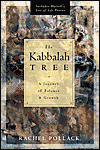
The Kabbalah Tree is the second project that Ms. Pollack has worked on with Hermann Haindl (the first is the Haindl Tarot, with Haindl as artist and Rachel as wordsmith). Ms. Pollack notes that the painting of Haindl's Tree of Life came after the deck was authored. This is an important point, indicating the growth of one from the other.
The book includes a poster of Haindl's Kabbalah Tree, and the poster alone is well worth the cover price. It is a glorious representation of the Tree of Life. Most of us, in imaging the kabbalistic tree see a graphic of the ten sephiroth and the 22 connecting paths in our mind. Perhaps we see the lightening path through the 10 sephiroth, or perhaps we take it one step further, and see the 10 sephiroth superimposed on the image of an actual tree. Mr. Haindl instead chose to realize the Tree of Life as a living tree, one which lives within each of us.
Each of the ten sephiroth contains an animal image, making it easy to understand the energy and movement of the Tree, and to begin to see how this works in our lives. Each of the ten sephiroth also contains the Hebrew letter attribution, and the Hebrew name. The twenty-two pathways carry the names of the twenty-two cards of the Tarot Major Arcana. From this foundation, the book begins.
Ms. Pollack does a very good job of using stories from many cultures, allowing her audience to reference her words to their own lives and backgrounds. For example, she makes an interesting point about the myth of the Tree of Life - that it occurs in different forms in different cultures, but that it is there. For instance, there is the Tree of Knowledge in the Garden of Eden; the tree of the crucifixion; Yggdrasil, the tree that Odin hung upside down from in Norse mythology before receiving the knowledge of the Runes; and the Bodhi tree that Buddha sat under. All trees relating to the roots of wisdom and life.
This is a complicated topic, and a complicated book that transmits a large amount of data, all relating to the Tree of Life. Ms. Pollack discusses things such as gematria - the application of numbers to letters, and its relationship to the Tree of Life. It is one of the many places we see that there are many paths through the Tree - all equally valid. Through the eyes of Jewish Kabbalah, Christian Kabbalah and the Kabbalah of Western Hermeticism (Golden Dawn) we see differing views and understandings of the Tree of Life.
There is also a short discussion of work done by Judith Laura on the sexual attributions for each sephiroth on the Tree of Life. The question posed here was whether the symbolism from the Tree of Life originated in the ancient goddesses of nature. The cross-polarity shown here give another form of balance to the Tree, and is worth considering.
Well organized and copiously referenced, Pollack does a fine job of combining the Jewish, Western, and Christian traditions associated with the Kabbalah Tree of Life. The Kabbalah Tree is a work of art in word form, presenting the history of the Kabbalistic Tree of Life, the thoughts of various authors along the way, and the myths and stories that make up its reality. I highly recommend this book as a resource for occult students of all levels.
~review by Lisa Mc Sherry
Author: Rachel Pollack
Llewellyn Publications, 2004
pp. 192, $16.95
For more infomration on Judith Laura's work, Goddess Spirituality for the 21st Century: From Kabbalah to Quantum Physics, please see Ms. Laura’s site at: http://www.judithlaura.com/gs21.html. An excerpted and condensed article on the Hermetic Qabalah section of that book can be found at: http://www.matrifocus.com/BEL02/myturn-qabalah.htm.
